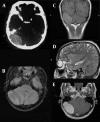Extramedullary plasmacytoma presenting as a solitary mass in the intracranial posterior fossa
- PMID: 23408237
- PMCID: PMC3569557
- DOI: 10.5812/iranjradiol.8759
Extramedullary plasmacytoma presenting as a solitary mass in the intracranial posterior fossa
Abstract
A patient with a 3-month history of headache refractory to pain medication was admitted. The CT scan and MRI showed evidence of a posterior fossa mass. This was pathologically confirmed as an extra medullary plasmacytoma (EMP). He had a pathologic fracture of the left humerus 7 years ago while the radiologist was unaware at the time of diagnosis. A solitary bone plasmacytoma (SBP) was the cause of the pathologic fracture. This report includes the first description of MRI findings in a patient with a rare-incidence intracranial solitary extra medullary plasmacytoma (SEP) in Iran. There is a striking similarity between the features of intracranial SEP and meningiomas. Intracranial SEP, although rare, should be included in the differential diagnosis of brain tumors in areas where meningiomas commonly arise. The MRI findings and differential diagnosis of plasmacytoma are reviewed. Before this case report, only few cases have been reported in the literature. Nonetheless, this is the first report of posterior fossa EMP from Iran.
Keywords: Magnetic Resonance Imaging; Plasmacytoma; Posterior Fossa.
Figures


References
-
- Galieni P, Cavo M, Pulsoni A, Avvisati G, Bigazzi C, Neri S, et al. Clinical outcome of extramedullary plasmacytoma. Haematologica. 2000;85(1):47–51. - PubMed
Publication types
LinkOut - more resources
Full Text Sources
